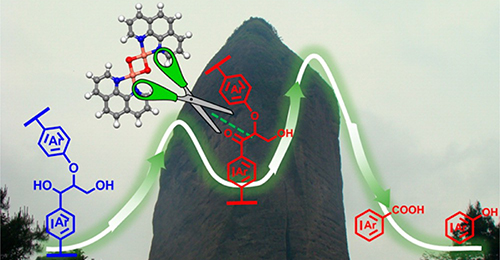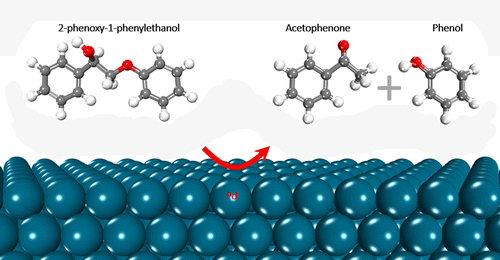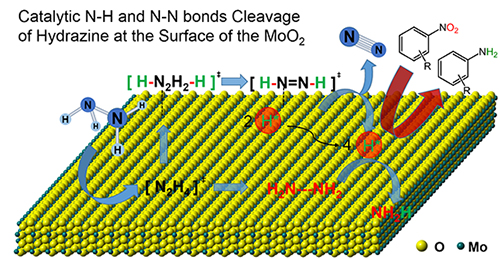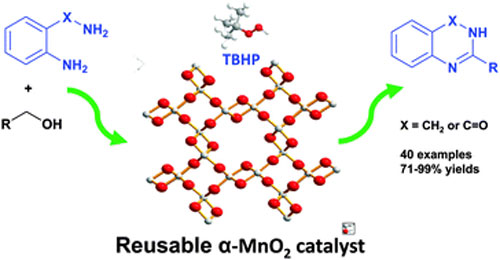
Zhixin Zhang, Yehong Wang, Min Wang, Jianmin Lu, Chaofeng Zhang, Lihua Li, Jingyang Jiang, Feng Wang*
Catal. Sci. Technol., 2016, 6(6), 1693-1700
We herein report the oxidative C–C coupling of ketones and primary alcohols to produce α,β-unsaturated ketones in the absence of base additives. This cascade synthetic reaction was conducted at 150 °C in 12 h using a heterogeneous CeO2 catalyst. The conversion of acetophenone reached 74% with 89% selectivity to chalcone. A correlation between the CeO2 crystal plane and catalytic performance is established as the catalytic activities decrease in the sequence of (110) > (111) > (100). Characterization using Raman spectroscopy, CO2 temperature-programmed desorption (CO2-TPD), and in situ active site-capping tests has shown that the unusual catalysis of the CeO2 catalyst is attributed to the coexistence of basic and redox active sites. These sites synergistically catalyze the oxidation of alcohols to aldehydes and the aldol condensation to ketones. Moreover, the CeO2 catalyst can be reused several times after calcination to remove the surface-adsorbed substances.

Zhixin Zhang, Yehong Wang, Jianmin Lu, Chaofeng Zhang, Min Wang, Mingrun Li, Xuebin Liu, Feng Wang*
ACS Catal., 2016, 6(12), 8248–8254
Conversion of low-carbon olefins to higher alcohols or olefins via the formation of C–C bonds is an increasingly important topic. We herein report an example of converting isobutene and formaldehyde (38 wt % aqueous solution) to 3-methyl-1,3-butanediol (MBD), a precursor for isoprene. The reaction occurs through a Prins condensation–hydrolysis reaction over a praseodymium (Pr)-doped CeO2 catalyst. The best MBD yield (70%) is achieved over the Pr-doped CeO2 catalyst. Catalyst characterizations wi

Nengchao Luo, Min Wang, Hongji Li, Jian Zhang, Huifang Liu, Feng Wang*
ACS Catal., 2016, 6(11), 7716–7721
One of the challenges of depolymerizing lignin to valuable aromatics lies in the selective cleavage of the abundant C–O bonds of β-O-4 linkages. Herein we report a photocatalytic oxidation–hydrogenolysis tandem method for cleaving C–O bonds of β-O-4 alcohols. The Pd/ZnIn2S4 catalyst is used in the aerobic oxidation of α-C–OH of β-O-4 alcohols to α-C═O with 455 nm light, and then a TiO2–NaOAc system is employed for cleaving C–O bonds neighboring the α-C═O bonds through a hydrogenolysis reaction b

Chaofeng Zhang, Jianmin Lu, Xiaochen Zhang, Katherine E MacArthur, Marc Heggen, Hongji Li, Feng Wang*
Green Chem., 2016,18(24), 6545-6555
Efficient cleavage of lignin β-O-4 ether bonds to produce aromatics is a challenging and attractive topic. Recently a growing number of studies reveal the initial oxidation of CαHOH to Cα=O can decrease the β-O-4 bond dissociation energy (BDE) from 274.0 kJ•mol-1 to 227.8 kJ•mol-1, and thus the β-O-4 bond is more readily cleaved in the subsequent transfer hydrogenation, or acidolysis. Here we show that the first reaction step, except in the above-mentioned pre-oxidation methods, can be a Cα-OH b

Min Wang, Jianmin Lu, Xiaochen Zhang, Lihua Li, Hongji Li, Nengchao Luo, Feng Wang*
ACS Catal., 2016, 6(9), 6086–6090
We herein report a two-step strategy for oxidative cleavage of lignin C–C bond to aromatic acids and phenols with molecular oxygen as oxidant. In the first step, lignin β-O-4 alcohol was oxidized to β-O-4 ketone over a VOSO4/TEMPO [(2,2,6,6-tetramethylpiperidin-1-yl)oxyl)] catalyst. In the second step, the C–C bond of β-O-4 linkages was selectively cleaved to acids and phenols by oxidation over a Cu/1,10-phenanthroline catalyst. Computational investigations suggested a copper-oxo-bridged dimer w

Jianmin Lu, Min Wang, Xiaochen Zhang, Andreas Heyden, Feng Wang*
ACS Catal., 2016, 6(8), 5589–5598
Lignin in lignocellulosic biomass is the only renewable source for aromatic compounds, and effective valorization of lignin remains a significant challenge in biomass conversion processes. We have performed density functional theory calculations and experiments to investigate the cleavage mechanism of the C–O ether bond in the lignin model compound 2-phenoxy-1-phenylethanol with a β-O-4 linkage over a Pd(111) catalyst surface model. We propose the favorable reaction pathway to proceed as follows
Haijun Chen, Chao Liu, Min Wang, Chaofeng Zhang, Gao Li*, Feng Wang*
Chin. J. Catal., 2016, 37(10), 1787-1793
Well-defined gold nanoclusters with average size less than 2 nm have emerged as a new and novel catalyst. The gold nanocluster loaded on the oxide surface usually aggregates to larger particles at high temperature (> 300 °C), which is caused by the removal of the surface ligands. We herein present a novel method to prepare Au25 cluster catalyst (∼1.3 nm) with high thermal stability (up to...
Xiaochen Zhang, Min Wang, Chaofeng Zhang, Jianmin Lu, Yehong Wang, Feng Wang*
RSC Adv., 2016, 6, 70842-70847
Crystalline Mo–V–O oxides have been used as a catalyst for the hydrolysis and alcoholysis of propylene oxide to diols and ethers, respectively. Relationships between the active crystal facet, the acidity of Mo–V–O catalysts and the activity have been established. Our results indicate that the a–b plane is the active facet for the hydrolysis reaction.
Chaofeng Zhang, Xu Wang, Mingrun Li, Zhixin Zhang, Yehong Wang, Rui Si, Feng Wang
Chin. J. Catal., 2016, 37(9), 1569-1577
We present an efficient approach for the chemoselective synthesis of arylamines from nitroarenes and formate over an oxygen-implanted MoS2 catalyst (O-MoS2). O-MoS2 was prepared by incomplete sulfidation and reduction of an ammonium molybdate precursor. A number of Mo–O bonds were implanted in the as-synthesized ultrathin O-MoS2 nanosheets. As a consequence of the different coordination ge...
Chaofeng Zhang, Zhixin Zhang, Xu Wang, Mingrun Li, Jianmin Lu, Rui Si, Feng Wang*
Appl. Catal. A: Gen., 2016, 525, 85-93
We present an efficient approach for chemoselective synthesis of various functionalized arylamines from nitroarenes over an oxygen-implanted MoS2 catalyst (O-MoS2). The HRTEM, XRD, XPS, Raman, EXAFS and NH3-TPD characterizations show the existence of MoIVOx structure and abundant coordinative unsaturated (CUS) Mo sites in the 2D-layer structure of O-MoS2. In the transfer hydrogenation of nitro...

Chaofeng Zhang, Jianmin Lu, Mingrun Li, Yehong Wang, Zhe Zhang, Haijun Chen, Feng Wang*
Green Chem., 2016, 18(8), 2435-2442
We present an experimental and computational study of the elementary steps of hydrazine hydrogen transfer on crystalline MoO2, and demonstrate its unique bifunctional metallic-basic properties in a catalytic hydrogenation reaction. Density functional theory (DFT) calculations suggest that the stepwise hydrogen transfer via the prior cleavage of the N–H bond rather than the N–N bond, is the key step to create the dissociated hydride and proton species on the dual Mo and O sites, marking its diffe
Min Wang, Jiping Ma, Miao Yu, Zhe Zhang, Feng Wang*
Catal. Sci. Technol., 2016, 6, 1940-1945
We herein report the transition metal oxide-catalyzed synthesis of azobenzenes through the oxidative coupling of anilines. An octahedral molecular sieve of manganese oxide, OMS-2, exhibited the best activity and selectivity. Nine examples of symmetric azobenzenes and twenty unsymmetric ones were synthesized with 62–99% conversion and 64–99% selectivity. In the aniline cross-coupling reactions...

Zhe Zhang, Min Wang, Chaofeng Zhang, Zhixin Zhang, Jianmin Lua, Feng Wang*
Chem. Commun., 2015,51(44), 9205-9207
Heterogeneously catalyzed synthesis of quinazolinones or quinazolines is reported in this study. An α-MnO2 catalyst is found to be highly active and selective in the oxidative cyclization of anthranilamides or aminobenzylamines with alcohols using TBHP as an oxidant. This protocol exhibits a broad substrate scope, and is operationally simple without an additive.